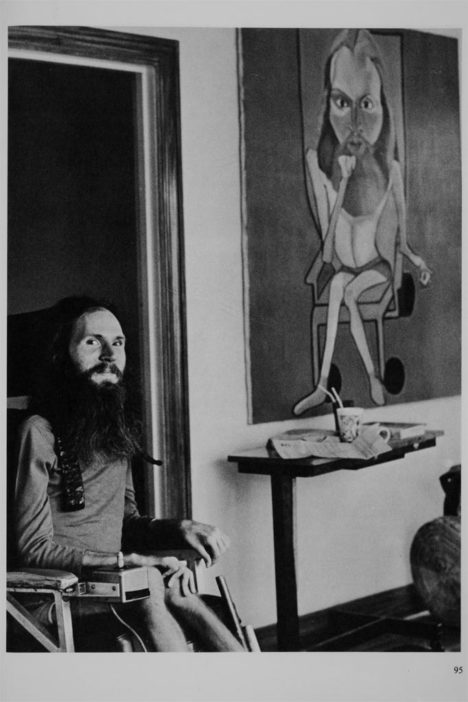In 1973, Peter Trier was admitted to UC Berkeley as a philosophy graduate student and entered the Cowell Hospital program, joining Mary Ann Hiserman and others. He was twenty-six years-old.
This photograph of Trier, published in Lifchez and Winslow’s Design for Independent Living, was taken by Lydia Mechanic, long after he left Cowell. Trier appears very comfortable in his home environment, situated next to a very grand portrait of himself.
The painting itself accentuates certain features over others, including the height of his chair-like throne, a strong jawline, and robust mane. His body language, with his hand resting under chin, visually rhymes with Rodin’s “The Thinker”—a reference to Trier’s appreciation for philosophical contemplation.
Coming to Berkeley, after experiencing round-the-clock parental care at home, was a radical experience for Trier; like many others, he took a while to adjust to the nascent crip culture.
In this excerpt from his oral history with Susan O’Hara, Trier shares his first experiences meeting other disabled students in the Cowell program and the insider crip knowledge passed down to residents:
“Trier: The classes I had were very exciting. I had very good teachers that were intellectually interesting. I never felt that much pressure to accommodate myself to Berkeley. There was a running joke at Cowell Hospital how concerned I was to protect my rational characteristics from being overwhelmed by Berkeley, and it was kind of a running joke how long it would be before I would first smoke marijuana. I think I made it all the way through Cowell without smoking marijuana, which was an extraordinary achievement coming from Cowell in those days.
The unjudgmental response at that point, which is a part of, in some ways, what drove the description we wrote for rehab assistance later on. It was a very tolerant atmosphere. There were people there who were very conservative; there were people there that were alcoholics or heavy drug users when I was first at Cowell. Everybody, the people that worked there and students, they had a pretty relaxed, tolerant, nonjudgmental attitude. I felt, to the degree that people thought that I was odd, they didn’t usually say it, so it got to be fairly comfortable.
There were–a certain number of people that were there–Mary Ann was wonderful, and Paul McBride, one of my attendants, and others. I felt I was treated very kindly.
O’Hara: Was there a certain lore that was passed on to you by some of these individuals, these mentors?
Trier: Oh, yes, sure, right away, yes. Well, first, one of the pieces of the lore was language. If you lived at Cowell for a year, the way you describe people with disabilities to other friends or something, you describe such people as crips. That was a term I had only heard once in my whole life. When someone used “crip,” it sounded wrong. Once, when someone tried to be cool, they used the word “crip.” There was kind of a heavy silence for two or three minutes. Otherwise, it was natural.
